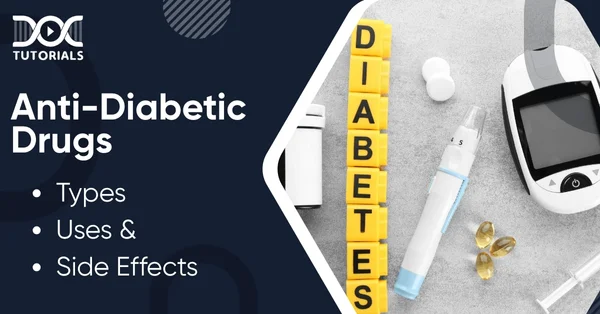Anti-Diabetic Drugs: Types, Uses, Side Effects & More

Diabetes is a chronic disease in which the body’s ability to control blood sugar is impaired. Antidiabetic drugs manage the disease by decreasing glucose levels in various ways. They are crucial for type 1 or type 2 diabetic patients and serve as life-saving medication for the millions affected by these conditions.
Knowing about the different kinds of anti diabetic drugs, what they treat, and their side effects is important for NEET PG students to improve treatment outcomes as future medical professionals. This guide focuses on the types of anti-diabetic drugs, their uses, precautions, and other crucial aspects.
Read on to know more!
What are Anti-Diabetic Drugs?
Anti-diabetic drugs are medications used to control blood sugar (glucose) levels in people with diabetes. They work through various mechanisms—some increase insulin production, others improve insulin sensitivity, and a few help the body eliminate excess glucose through urine.
These drugs are mainly used for type 2 diabetes. Meanwhile, insulin is chiefly used for type 1 diabetes and in some cases, for type 2 diabetes patients.
Depending on the individual case, a doctor might prescribe one or a combination of anti-diabetic medications. Lifestyle changes like diet and exercise are always recommended alongside medication.
What are the Types of Anti-Diabetic Drugs?
There are several types of anti-diabetic drug classifications. Each class of these medicines works differently to lower blood glucose levels and is chosen based on the individual’s specific needs:
- Biguanides
Biguanides are often the first medicine prescribed for type 2 diabetes. Metformin is the most widely used drug in this class. It works by reducing glucose production in the liver. It also helps the body use insulin more effectively and improves insulin sensitivity.
- Sulfonylureas
These drugs help stimulate the pancreas to release more insulin. Examples include glimepiride, glipizide, and glyburide. These medicines can effectively lower blood sugar but may cause hypoglycemia. They are often used when metformin alone is not enough.
- DPP-4 Inhibitors (Gliptins)
These medications help the body increase insulin production after meals. Drugs like sitagliptin, saxagliptin, and linagliptin belong to this group. They also reduce the amount of sugar released by the liver.
- SGLT2 Inhibitors
These drugs help remove excess glucose from the body through urine. Examples include empagliflozin, canagliflozin, and dapagliflozin. They work by preventing the kidneys from reabsorbing glucose back into the blood.
- GLP-1 Receptor Agonists
These are injectable drugs that mimic a natural hormone to help control blood sugar. Liraglutide, semaglutide, and exenatide are common examples.
- Thiazolidinediones (TZDs)
These drugs improve how the body uses insulin. Pioglitazone and rosiglitazone are part of this class. They work slowly but have long-lasting effects.
- Insulin
Insulin is required for all patients with type 1 diabetes and some with type 2 diabetes. It replaces the insulin that the body cannot produce. The different types of insulin are: rapid-acting, short-acting, intermediate, and long-acting.
What are the Uses of Anti-Diabetic Drugs?
Antidiabetic drugs are used to manage high blood sugar and prevent complications such as nerve damage, kidney disease, and heart problems. The choice of drug depends on the type of diabetes and other health factors.
- Metformin is usually the first choice for type 2 diabetes because of its effectiveness and safety.
- Sulfonylureas are used as add-on therapy when metformin alone is not enough.
- SGLT2 inhibitors and GLP-1 receptor agonists are often prescribed to patients with heart or kidney concerns.
- Insulin therapy is essential for people with type 1 diabetes and those with uncontrolled type 2 diabetes.
- DPP-4 inhibitors are good options for older adults or people who cannot tolerate other medications.
What are the Side Effects of Anti-Diabetic Drugs?
All anti-diabetic medications can have side effects. Some are mild and temporary, while others may need medical attention. Below are a few important ones:
- Metformin can cause stomach upset, nausea, or diarrhoea, especially when first started.
- Sulfonylureas may cause low blood sugar and weight gain if meals are skipped.
- SGLT2 inhibitors can increase the risk of urinary tract infections and dehydration.
- GLP-1 receptor agonists can lead to nausea, vomiting, and sometimes constipation.
- TZDs may cause fluid retention and increase the risk of heart failure.
- Insulin can cause low blood sugar and weight gain if not used carefully.
What are the Precautions to Take for Anti-Diabetic Drugs?
Here are a few precautions that should be followed to ensure safety and effectiveness while treating diabetic patients:
- Patients using metformin should avoid alcohol and monitor kidney function, as there is a rare risk of lactic acidosis.
- People on sulfonylureas must eat regularly to avoid low blood sugar.
- Those taking SGLT2 inhibitors should stay hydrated to avoid dehydration.
- GLP-1 receptor agonists should be used cautiously in people with a history of pancreatitis.
- TZDs should not be used in people with existing heart failure.
- All patients taking insulin should regularly check their blood sugar to avoid hypoglycemia.
FAQs About Anti-Diabetic Drugs
- What is the most common oral medication for Type 2 diabetes?
Metformin is the most commonly prescribed oral anti-diabetic drug for Type 2 diabetes.
- What are the side effects of oral diabetes medications?
Common side effects include nausea, diarrhoea, low blood sugar, weight gain, and increased risk of infections, depending on the drug class.
- Do oral anti-diabetic drugs interact with other medications?
Yes, oral antidiabetic drugs can interact with other medications such as steroids, blood pressure medicines, and antibiotics.
- What to do if a dose of diabetes medication is missed?
The patients can take the missed dose as soon as they remember, but skip it if it’s almost time for the next dose.
- Can lifestyle changes reduce the need for diabetes medication?
Yes, healthy eating, weight loss, and regular exercise can reduce the need for diabetes medication in some cases.
Conclusion
Antidiabetic drugs are essential for managing blood sugar levels and preventing complications in people with diabetes. Understanding the different types, their uses, possible side effects, and necessary precautions helps medical practitioners ensure safe and effective treatment. Along with medication, lifestyle changes play a key role in long-term diabetes control. Regular monitoring and close communication with healthcare providers are vital for successful diabetes management.
At DocTutorials, we provide students with detailed NEET PG study material on Pharmacology, Medicine, Surgery, and several other essential aspects. With our systematic approach and expert coaching, students can become successful doctors and have a deep understanding of the medical profession.
Enrol in our courses today!
Latest Blogs
-

NEET PG Exam 2025- Date, Pattern, Marking Scheme, Subject Wise Weightage, and Exam Mode
NEET PG Exam 2025 is the ultimate gateway for medical graduates aspiring to pursue postgraduate courses in medicine, including MD,…
-

INI CET Exam 2025: Your Roadmap to Success – Key Topics, Strategies, and Lessons from Last Year’s Papers
The INI CET exam is more than just a test; it’s a significant milestone for many medical students aiming to…
-

INI CET Exam Success: Previous Year Question Papers & Ultimate Guide – INI CET PYQ
One can feel overwhelmed while preparing for the INI CET (Institute of National Importance Combined Entrance Test). A vast syllabus,…




